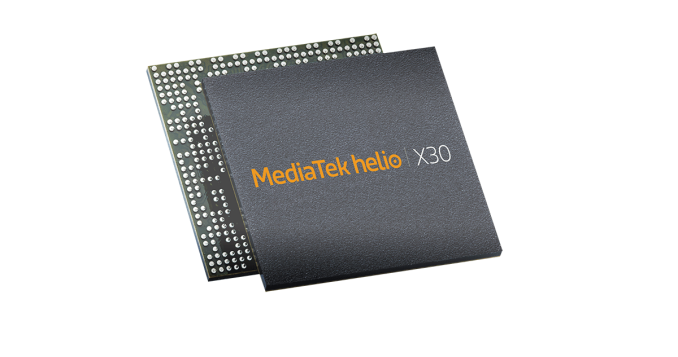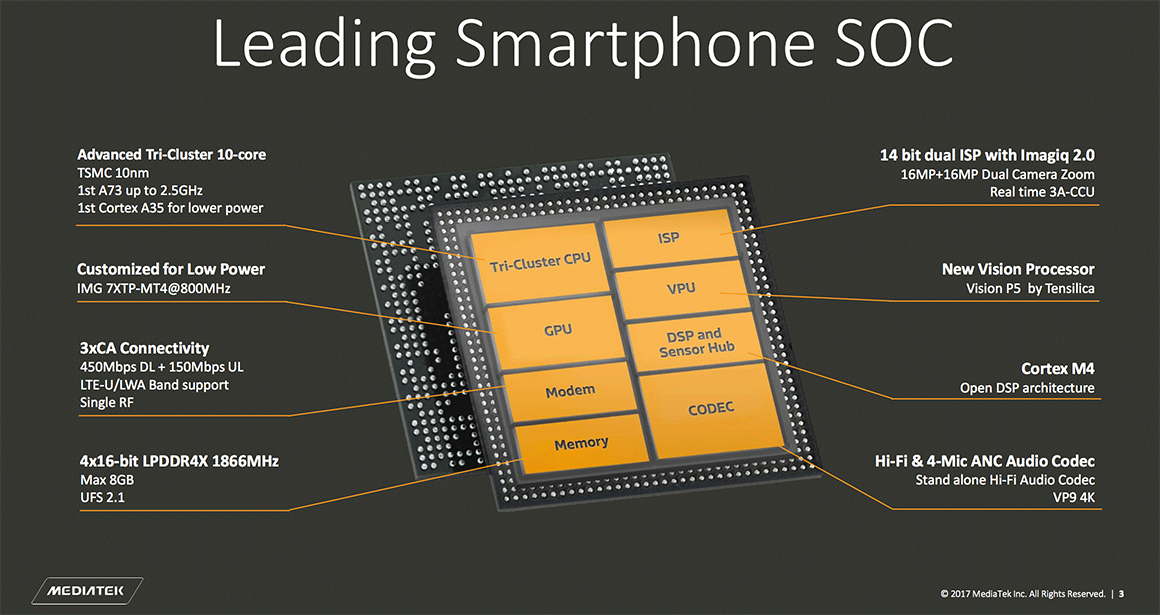MediaTek Announces Helio X30 Availability: 10 CPU Cores On 10nm
by Matt Humrick on February 27, 2017 8:35 PM EST- Posted in
- Smartphones
- Mobile
- Trade Shows
- SoCs
- MediaTek
- Helio
- MWC_2017
- Helio X30

MediaTek first unveiled the Helio X30—its next-generation high-end SoC—last fall, but today at Mobile World Congress the Taiwanese company announced its commercial availability. The Helio X30 is entering mass production and should make its debut inside a mobile device sometime in Q2 2017.
The Helio X30, like the Helio X20 family before it, incorporates 10 CPU cores arranged in a Max.Mid.Min tri-cluster configuration. Two of ARM’s latest A73 CPU cores replace the two A72s in the Max cluster, which should improve performance and reduce power consumption. The Mid cluster still uses 4 A53 cores, but they receive a 10% frequency boost relative to the top-of-the-line Helio X27. In the X30’s Min cluster we find the first implementation of ARM’s most-efficient A-series core. The A35 consumes 32% less power than the A53 it replaces (same process/frequency), while delivering 80%-100% of the performance, according to ARM. With a higher peak frequency of 1.9GHz, the X30’s A35 cores should deliver about the same or better performance than the X20’s A53 cores and still consume less power.
| MediaTek Helio X20 vs. Helio X30 | ||
| SoC | MediaTek Helio X20 |
MediaTek Helio X30 |
| CPU | 2x Cortex-A72 @2.1GHz 4x Cortex-A53 @1.85GHz 4x Cortex-A53 @1.4GHz |
2x Cortex-A73 @2.5GHz 4x Cortex-A53 @2.2GHz 4x Cortex-A35 @1.9GHz |
| GPU | ARM Mali-T880MP4 @780MHz |
PowerVR 7XTP-MT4 @800MHz |
| Memory Controller |
2x 32-bit @ 933MHz LPDDR3 14.9GB/s b/w |
4x 16-bit @ 1866MHz LPDDR4x 29.9GB/s b/w |
| Video Encode/ Decode |
encode: 2160p30 H.264 / HEVC w/HDR decode: 2160p30 10-bit H.264 / HEVC / VP9 |
encode: 2160p30 H.264 / HEVC w/HDR / VP9 decode: 2160p30 10-bit H.264 / HEVC / VP9 |
| Camera/ISP | Dual ISP 32MP @ 24fps (single camera) or 13MP + 13MP @ 30fps (dual camera) |
Dual 14-bit ISP 28MP @ 30fps (single camera) or 16MP + 16MP (dual camera) |
| Integrated Modem |
LTE Category 6 DL = 300Mbps 2x20MHz CA, 64-QAM UL = 50Mbps 1x20MHz CA, 16-QAM FDD-LTE / TD-LTE / TD-SCDMA / WCDMA / CDMA / GSM |
LTE Category 10 DL = 450Mbps 3x20MHz CA, 64-QAM UL = 150Mbps 2x20MHz CA, 64-QAM FDD-LTE / TD-LTE / TD-SCDMA / WCDMA / CDMA / GSM |
| Mfc. Process | TSMC 20SoC (planar) | TSMC 10nm FinFET |
The Helio X30 will also be the first SoC to use TSMC’s 10nm process, which will offer significant power savings relative to TSMC’s 20nm planar process that the Helio X20 family uses. According to MediaTek, the X30 consumes 50% less power than the X20 when running an unspecified CPU workload and 60% less power when running GFXBench T-Rex. These power savings will increase battery life and improve sustained performance with less thermal throttling.
Alongside the Helio X30, MediaTek is launching CorePilot 4.0, which manages CPU frequency and task scheduling. Optimized for its unique tri-cluster CPU configuration, CorePilot keeps track of the SoC’s power budget by monitoring temperature, and the global task scheduler component is responsible for migrating tasks between clusters based on workload and user experience parameters, such as frames per second. It also adjusts CPU frequency using Fast DVFS technology that increases sampling rate, allowing for faster voltage/frequency adjustments that better follow changes in workload. The overall goal of CorePilot 4.0 is to achieve the best possible performance at the lowest power levels.
In a short presentation at its MWC booth Monday, Executive Vice President & Co-COO Jeffrey Ju stated that MediaTek expects only a limited number of phones to use the Helio X30, perhaps less than ten. He also mentioned that a low yield rate for TSMC’s 10nm process has delayed the X30’s availability. The X30 sounds compelling on paper, so it will be interesting to see how many design wins it can actually achieve.











57 Comments
View All Comments
beginner99 - Tuesday, February 28, 2017 - link
Does this tri-cluster really make any sense besides marketing? Why not just leave the A53 cores away if the A35 are almost as powerful?Amandtec - Tuesday, February 28, 2017 - link
On previous Mediatek models it didn't work so well, but if they get it right, including the software that manages the process, then obviously it can make a difference.R0H1T - Tuesday, February 28, 2017 - link
It might just be the licensing costs &/or die space required for A53 which makes it (still) competitive wrt the A35, that or A53 > A35 in layman's terms cause numbers!MrSpadge - Tuesday, February 28, 2017 - link
Good question: leaving out the A53 and maybe adding 2 more A73 could be interesting as well.name99 - Tuesday, February 28, 2017 - link
A more technical isssue; is CorePilot (and specifically CorePilot 4) software or hardware?If it's software, so it's just yet another slightly tweaked OS governor, that's not especially interesting. But if they have (FINALLY...) moved DVFS control into HW (the way Intel did at Skylake) that has the potential for a substantial improvement in power+responsivity.
haukionkannel - Tuesday, February 28, 2017 - link
Pure marketing! More cores!Much better with four A35 and two or four A73... But nobody in china would buy "only six or eight core" CPU...
ppi - Tuesday, February 28, 2017 - link
No H.265?!eduardor2k - Tuesday, February 28, 2017 - link
H265 = HEVCfm13 - Tuesday, February 28, 2017 - link
hey, will Anandtech cover the Xiaomi Pinecone SoC launch today? it's 4xA73@2.7GHz + 4xA53@2.0GHz with Mali-G71 MP12@900MHz on a 10 nm Samsung process. looks very interesting.milli - Tuesday, February 28, 2017 - link
Why no mention in the article about the switch to PowerVR?